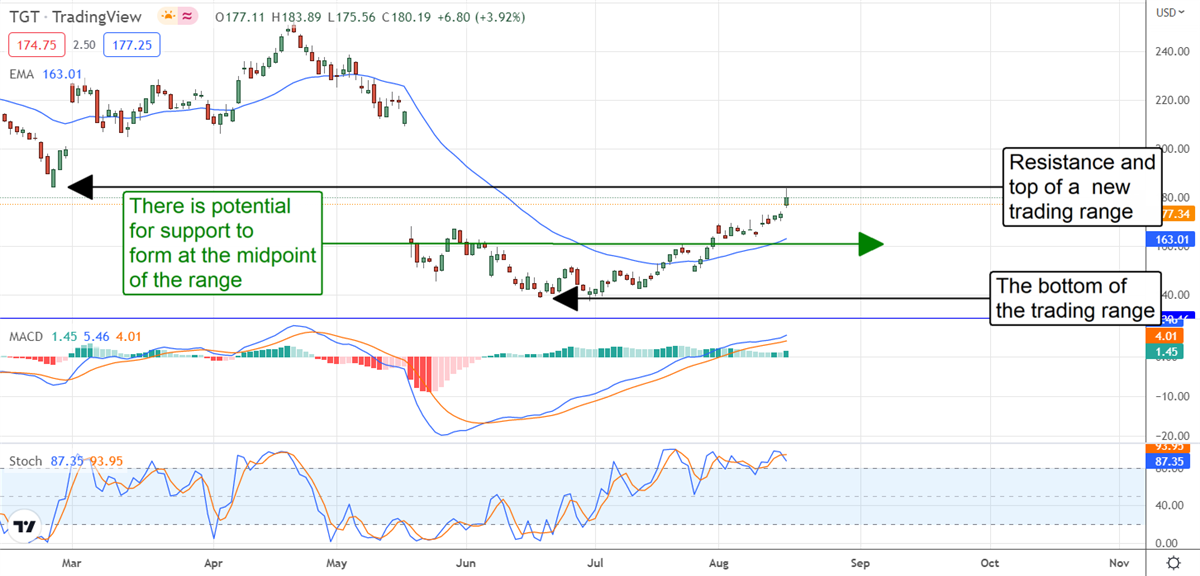
Target’s (NYSE: TGT) Q2 results reinforce a problem facing the retail sector that was only hinted at by Walmart (NYSE: WMT) and Home Depot (NYSE: HD) earlier in the week. The company’s efforts to combat supply chain and inventory hurdles are catching up with it at the same time that demand is falling. In the case of Home Depot, inventory is up 35% YOY and more than 30% higher than what the analysts were calling for while Walmart reported a 25% YOY increase.
What this means for Target is a build-up of unwanted merchandise that it decided to liquidate at the cost of margin, but we knew this. The company warned us this was going to happen but there is a problem. Target missed the consensus expectation on the top and bottom line because of the amount of discounting and this weakness will most likely spill over into the broader retail sector.
The good news is that, while the remainder of the retail industry is still facing the challenges of bloating inventories Target already took the bull by the horns and made the tough decision to sell at whatever price it could. Soon, the company will be ready for the next consumer rebound and is a high-probability candidate to lead the market. The takeaway is that Target's stock price could pull back from the current levels and even retest the most recent lows, and bring the retail sector down with it, but it could bottom before its peers and come out of the dark times soonest.
Target Reduces Inventory?
Target’s Q2 results were deeply impacted by its inventory-reducing actions which might lead you to believe inventory came down during the quarter. The head-scratching detail is that inventory increased by 10% YTD and 35% YOY on efforts to position the company for sales in high-demand items. This could be a good move for the company but may also backfire if sales lag expectations and inventories remain bloated. Until then, the $26.04 billion in revenue reported for the 2nd quarter is up 3.5% versus last year on an increase in traffic and digital sales but missed the consensus by 12 basis points. The 12 basis points is a slim margin but weakness on top of a profit warning is doubly bad, especially when there are other factors cutting into the top and bottom line as well.
The news gets worse as we approach the bottom line of the report. The gross and operating margins came under pressure due to the discounting but also because of higher freight, transportation, and final-mile costs along with higher wages and an increased headcount. The takeaway here is that adjusted EPS came in at a mere $0.39 compared to the $0.72 projected by Marketbeat’s analyst data and down from every comparison of the last 5 or so years including the worst quarter of the pandemic. As for the guidance, the company is expecting to see some revenue and margin strength return in the back half of the year, and was able to maintain the guidance opens the door to an upside surprise in Q3 and Q4.
Target Is On Target With Its Capital Returns
The revenue and earnings news is lackluster at best but does little to hurt the capital return outlook, at least for now. The company yields about 2.4% on a forward basis and has $9.7 billion left under the current share repurchases authorization. Target repurchased $2.6 billion during the quarter which is worth about 3.1% of the current market cap, the $9.7 billion left on the authorization is worth another 11.6%, and dividend increases, at least, are still expected. The company has raised for more than 50 consecutive years and pays out a low 28% of the earnings consensus so there is a safety factor in play as well.
Turning to the chart, the stock is down more than 2.5% in premarket trading and confirming resistance at the $184 level. The resistance was first indicated during the previous session on a move driven by results from Walmart and Home Depot. Now, with shares moving lower, it looks like the top of a range has been confirmed as well. In this light, it is reasonable to expect Target to trend lower in the near to mid-term and hit a bottom in the $140 to $160 range before making the next move higher. 




